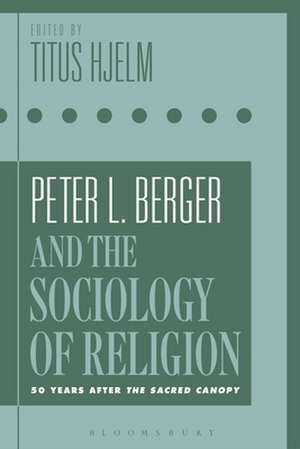Peter L. Berger and the Sociology of Religion: 50 Years after The Sacred Canopy
Editat de Titus Hjelmen Limba Engleză Paperback – 19 feb 2020
| Toate formatele și edițiile | Preț | Express |
|---|---|---|
| Paperback (1) | 223.58 lei 6-8 săpt. | |
| Bloomsbury Publishing – 19 feb 2020 | 223.58 lei 6-8 săpt. | |
| Hardback (1) | 714.68 lei 6-8 săpt. | |
| Bloomsbury Publishing – 22 aug 2018 | 714.68 lei 6-8 săpt. |
Preț: 223.58 lei
Preț vechi: 288.27 lei
-22% Nou
Puncte Express: 335
Preț estimativ în valută:
42.78€ • 44.67$ • 35.41£
42.78€ • 44.67$ • 35.41£
Carte tipărită la comandă
Livrare economică 04-18 aprilie
Preluare comenzi: 021 569.72.76
Specificații
ISBN-13: 9781350152113
ISBN-10: 1350152110
Pagini: 224
Ilustrații: 10 bw illus
Dimensiuni: 156 x 234 x 18 mm
Greutate: 0.31 kg
Editura: Bloomsbury Publishing
Colecția Bloomsbury Academic
Locul publicării:London, United Kingdom
ISBN-10: 1350152110
Pagini: 224
Ilustrații: 10 bw illus
Dimensiuni: 156 x 234 x 18 mm
Greutate: 0.31 kg
Editura: Bloomsbury Publishing
Colecția Bloomsbury Academic
Locul publicării:London, United Kingdom
Caracteristici
Introduces the influence and impact of one of the most important sociologists of religion, Pete L. Berger
Notă biografică
Titus Hjelm is Reader in Sociology at University College London, UK. His publications include Is God Back? (Bloomsbury Academic, 2015), and Social Constructionisms (2014). He is founding chair of the American Academy of Religion's Sociology of Religion Group.
Cuprins
List of Contributors Preface and Acknowledgements 1. Introduction: Peter L. Berger and the Sociology of Religion, Titus Hjelm (University College London, UK) 2 . Vulnerability and Plausibility Structures: Peter L. Berger, Arnold Gehlen and Philosophical Anthropology, Bryan S. Turner (The City University of New York, USA) 3. From Canopies to Conversations: The Continuing Significance of "Plausibility Structures", Nancy Ammerman (Boston University, USA) 4. The Sacred Canopy as a Global Construction Project: Incorporating both Emotional and Cognitive Resources, Doyle Paul Johnson (Independent scholar) 5. The Sacred Canopy as a Classic: Why Berger's Conceptual Apparatus Remains Foundational 50 Years Later, David Feltmate (Auburn University at Montgomery, USA) 6. Sacred Canopies and Invisible Religions: The Dialectical Construction of Religion in Berger and Luckmann, Hubert Knoblauch (The Technical University of Berlin, Germany) and Silke Steets (Leipzig University, Germany) 7. Secularization: From Sacred Canopies to Golf Umbrellas, Steve Bruce (University of Aberdeen, UK) 8. Islamic Revivalism and Europe's Secular 'Sacred Canopy': Exploring the Debunking Capacity of Public Religion, Riyaz Timol (Cardiff University, UK) 9. Religious American and Secular European Courts, or vice versa? A study of institutional cross-pollination, Effie Fokas (Hellenic Foundation for European and Foreign Policy, Greece) 10. Assessing the Influence of The Sacred Canopy: A Missed Opportunity for Social Constructionism?, Titus Hjelm (University College London, UK) Notes Bibliography Index
Recenzii
I've personally been eager for someone to put together a volume of this kind. There's no question that The Sacred Canopy is a classic that is still influential and deserves this kind of critical appraisal.
This book could prove to be the foundation for the social constructivist theoretical approach in the sociology of religion. In the sense of constructive criticism, this volume is the best thing that can happen to a life's work.
A thought-provoking conversation about the significance and implications of Peter Berger's work. Each of the contributors brings a lifetime of reflection on the sociological study of religion. Together, they show the complexity of Berger's thought and its continued relevance to sociology today. This is not mere hagiography. The chapters reveal aspects of Berger's thought that other writers have missed.
Peter Berger's work has been pivotal for both sociology and the sociology of religion. It still is. The essays brought together in this volume speak to the continuing significance of The Sacred Canopy for an interesting mix of scholars: some senior and some less so; some fascinated by theory and some by its applications in the field. I recommend it warmly.
This book could prove to be the foundation for the social constructivist theoretical approach in the sociology of religion. In the sense of constructive criticism, this volume is the best thing that can happen to a life's work.
A thought-provoking conversation about the significance and implications of Peter Berger's work. Each of the contributors brings a lifetime of reflection on the sociological study of religion. Together, they show the complexity of Berger's thought and its continued relevance to sociology today. This is not mere hagiography. The chapters reveal aspects of Berger's thought that other writers have missed.
Peter Berger's work has been pivotal for both sociology and the sociology of religion. It still is. The essays brought together in this volume speak to the continuing significance of The Sacred Canopy for an interesting mix of scholars: some senior and some less so; some fascinated by theory and some by its applications in the field. I recommend it warmly.
